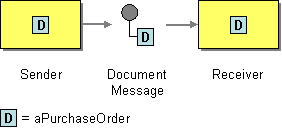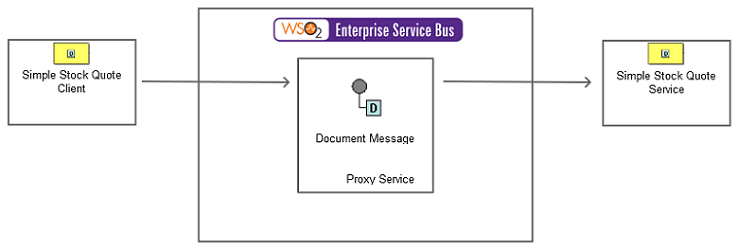This section explains, through an example scenario, how the Document Message EIP can be implemented using the WSO2 ESB. The following topics are covered:
Introduction to Document Message
The Document Message EIP is used to reliably transfer a data structure between applications. The Command Message EIP allows you to invoke only a specific client through the ESB, while the Document Message EIP sends the entire data unit to the receiver. For more information, see http://www.eaipatterns.com/DocumentMessage.html.
Figure 1: Document Message EIP
Example scenario
This example demonstrates how the ESB transmits an entire message from a client to a sample Axis2 server as a document message. Then the Axis2 server processes the message and identifies which operation to invoke.
The following diagram depicts this process.
Figure 2: Example scenario of the Document Message EIP
Before digging into implementation details, let's take a look at the relationship between the example scenario and the Document Message EIP by comparing their core components.
| Document Message EIP (Figure 1) | Document Message Example Scenario (Figure 2) |
|---|---|
| Sender | Stock Quote Client |
| Document Message | Proxy Service |
| Receiver | Simple Stock Quote Service |
The ESB configuration
Given below is the ESB configuration for simulating the example scenario explained above.
<?xml version="1.0" encoding="UTF-8"?>
<definitions xmlns="http://ws.apache.org/ns/synapse">
<proxy name="DocumentMessageProxy" transports="https http" startOnLoad="true" trace="disable">
<target>
<inSequence>
<send>
<endpoint>
<address uri="http://localhost:9000/services/SimpleStockQuoteService" />
</endpoint>
</send>
</inSequence>
<outSequence>
<send />
</outSequence>
</target>
</proxy>
</definitions>
The configuration elements
Let's investigate the elements of the configuration in detail.
- Proxy Service - The proxy service takes requests and forwards them to the back-end service, abstracting the routing logic from the client. In this example scenario, the proxy service just forwards requests to the back-end service following the Document Message EIP style.
Simulating the example scenario
Now, let's try out the example scenario explained above.
Setting up the environment
You need to set up the ESB, and the back-end service:
- Download the
Document-Message_1.0.0.zipfile, which includes the ESB configuration described above. - See Setting up the Environment for instructions on setting up the ESB and the back-end service.
Executing the sample
Send the following request to the ESB, by using a SOAP client: Note that the entire request will be passed to the back-end Axis2 Server, and the client will receive the response in return.
Request command:
ant stockquote -Dtrpurl=http://localhost:8280/services/DocumentMessageProxy
Analyzing the output
Stock Quote Client output:
Standard :: Stock price = $72.78678053494932
Axis2 server console output:
samples.services.SimpleStockQuoteService :: Generating quote for : IBM

